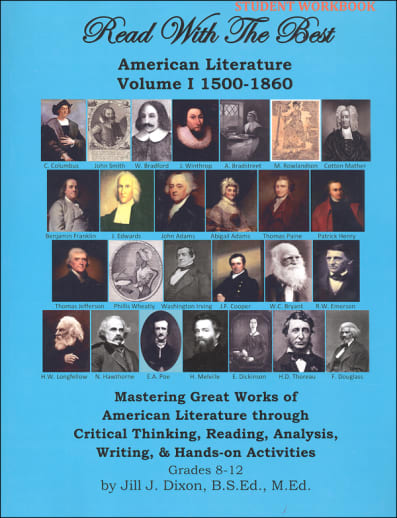This is the first year of a two year program in American Literature. The author, Jil Dixon, chose to divide American Lit into two years instead of the typical one in order to provide more thorough author/works coverage, noting that many of these works provide excellent vehicles for the introductory literature and composition skills usually found in first year high school courses. Interestingly, there is enough background research required that each course can also be counted as a 1/4 credit in American history.
The course is organized into 34 weekly study units which include one or more literature selections. The two remaining weeks are reserved for review and tests. Each selections study includes author/setting background information (student researches); a "Words to Know" section that requires the student to determine the part of speech, provide synonyms, and use in sentences; and questions for both literary analysis and critical reading. Each week the student is challenged to "make it real." For instance: "Think of two examples of foils in literature or movies" or "Name at least one stereotype or stock character that Irving portrays in Rip Van Winkle." Writing assignments are also part of each weeks study. As previously mentioned, these are typically coordinated with Write with the Best. There is also a weekly "culminating activity". These activities vary greatly but tend to be more hands-on and often something that will be more meaningful and fun if done in a group. Vocabulary and Literary Terms Tests are given every six weeks.
The Student Worktext is consumable and designed to provide both an excellent study tool and comprehensive test-prep review material. Introductory material and a weekly schedule (in the form of a checklist) communicate to the student the courses independent study nature. Writing space for all assignments is provided although some students may prefer to complete the composition assignments on the computer.
The Teachers Edition is essentially a full-text answer key but also includes vocabulary and literary terms test masters (reproducible for family) along with their answer keys. There is also a research paper checklist that can be reproduced for the student.
Required resources: Many of the literature selections can be found for free online. If you prefer a print resource, most of them are available in the first volume of The Norton Anthology of American Literature Shorter 9th Ed. Although the Shorter 7th Edition is recommended in the introduction to the course, this is now out of print. All literature selections used can be found in the first volume of the Shorter 9th Edition, with these exceptions: The Letters of John and Abigail Adams, the poem "A Slave's Dream" by Henry Wadsworth Longfellow and Patrick Henry's "Give Me Liberty" speech. The full-length work studied in this volume is The Scarlet Letter by Nathaniel Hawthorne. Although the Kaplan SAT Score Raising Classic version is recommended, this edition is currently out of print. We offer several other versions of this classic.
Other required resources used in this program include: Write with the Best Volume 2 (#019034), The American Heritage Dictionary and Thesaurus (#035790), Writing a Research Paper: A Step by Step Approach (#054413), and Writing a Research Paper Teachers Edition (#054414).

